Growth Hacking SEO + Digital Marketing with AdLift
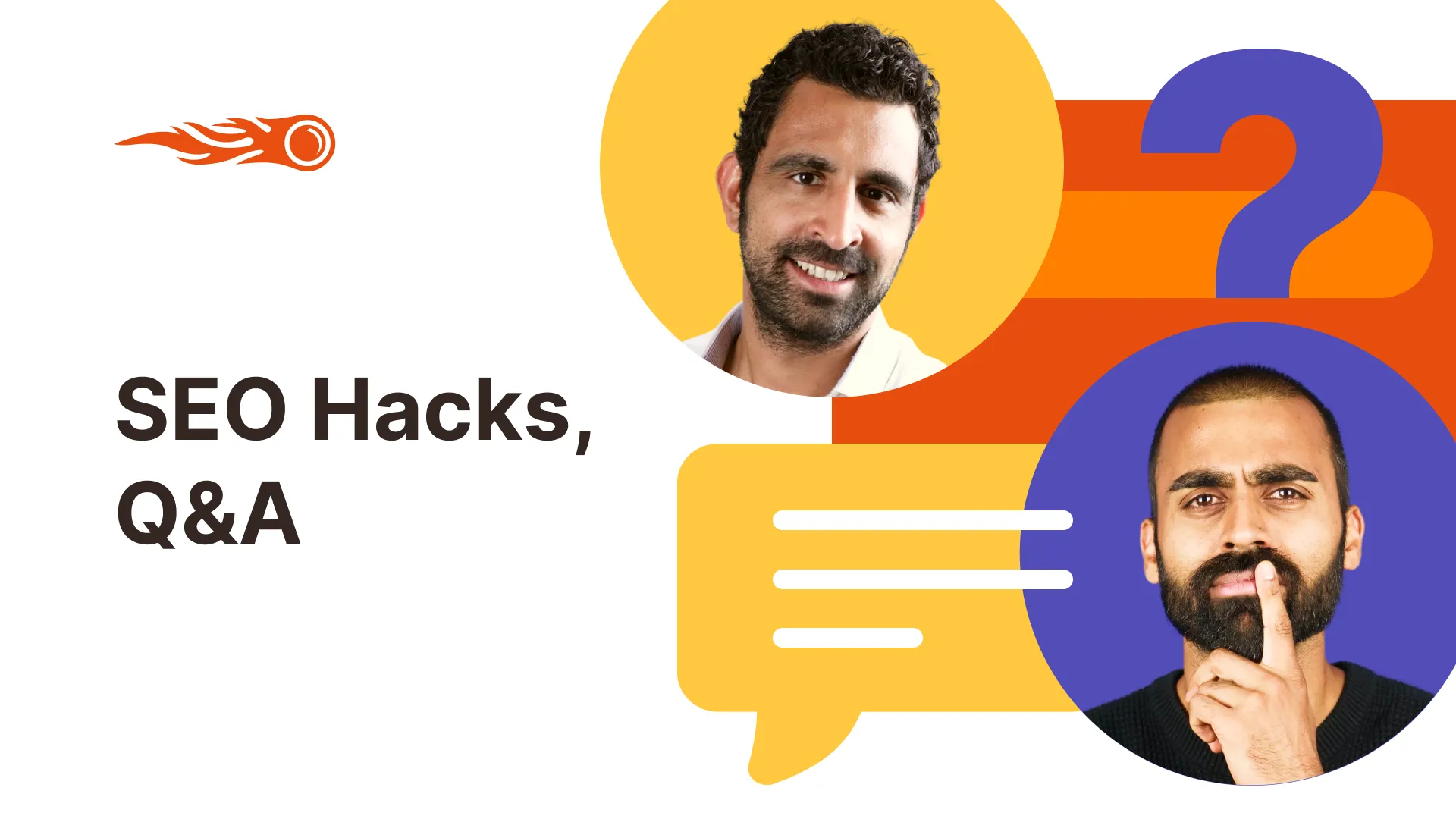
Deepak Shukla:
Good afternoon everybody. You hopefully know who I am right now, Deepak, Deepak, and I’ve got the wonderful Prashant on my side with me today. So, welcome everybody. Hello, Ramesh, Billy, Chris, Mitchell, Namrata, Abhinay, Sanchal. We’ve got a really exciting webinar ahead of us.
This is my first webinar on SEMrush with slides. Never actually done one before like that, so no pressure, Prashant. Breathe, but it’s going to be really good; I’ve seen the slides.
We’ve got a really good international audience at the moment. We’ve got, of course, a lot of people from India. We’ve got Canadians. We’ve got a couple of people from the States. We’ve got a Brit. We’ve got a Lithuanian. We’ve got a Mongolian, of course.
Mr. Prashant Puri, welcome. We’ve got the CEO and founder of AdLift, and I’m really, really excited for the audience actually today as well as myself because Prashant has got over 15 years of experience in the SEO and digital marketing game, and he’s going to be walking us through some really, really fascinating stuff.
Today, we’re going to be talking about ultimately some of his top hacks when it comes to digital marketing. He’s going to talk about his experience of building out an agency.
He’s going to talk about what it’s like to work with some really, really top-tier companies to include PayPal, Airbnb, and he’s going to also tell us being in the game for 15 years, he’s going to talk about the things that he wishes he knew 10 years ago. Prashant, how are you doing?
Prashant Puri:
Awesome. It’s great to be here, Deepak. Fantastic, and the audience is super international, so this should be fun.
Deepak Shukla:
I know that Prashant is going to share with you something that he prepared earlier that is going to enlighten everybody about some things that they could do differently in digital marketing today. Prashant, over to you, sir.
Five Power Hacks for Success in SEO
Prashant Puri:
Awesome. I’m going to go ahead and share my screen really quick. I’m here talk about the five power hacks. Although if we had time, we’d probably cover 15 or 20, but the five go-to hacks. If you’re new into SEO, these are your go-to. If you’ve already been doing SEO for a while, and you’ve not covered these, I would take that as key takeaways.
Before I get into the five hacks, a quick introduction. I’ve been in SEO and digital marketing for about 15 years, working across the board with F500s and startups. DNA is pretty much is SEO. So, eBay, AT&T, Yahoo, managing enterprise SEO.
Over the last 11 years that AdLift’s been around, we’ve worked with upwards of 250 global clients, some startups, some F500s, and a bunch of clients within the APAC India region. With that, I’m going to start to share my five favorite go-to SEO strategy.
Number one is you’ve got to dive into synergies between paid and SEO, and if I had a nickel for every time this went wrong, I’d be a millionaire, right? Typically, in organizations, we’ve got separate paid media teams. We’ve got separate SEO teams, so we’ve got separate SEO agencies and separate paid media agencies, which is fine, right? Those are two different skill sets, but they need to start talking to each other.
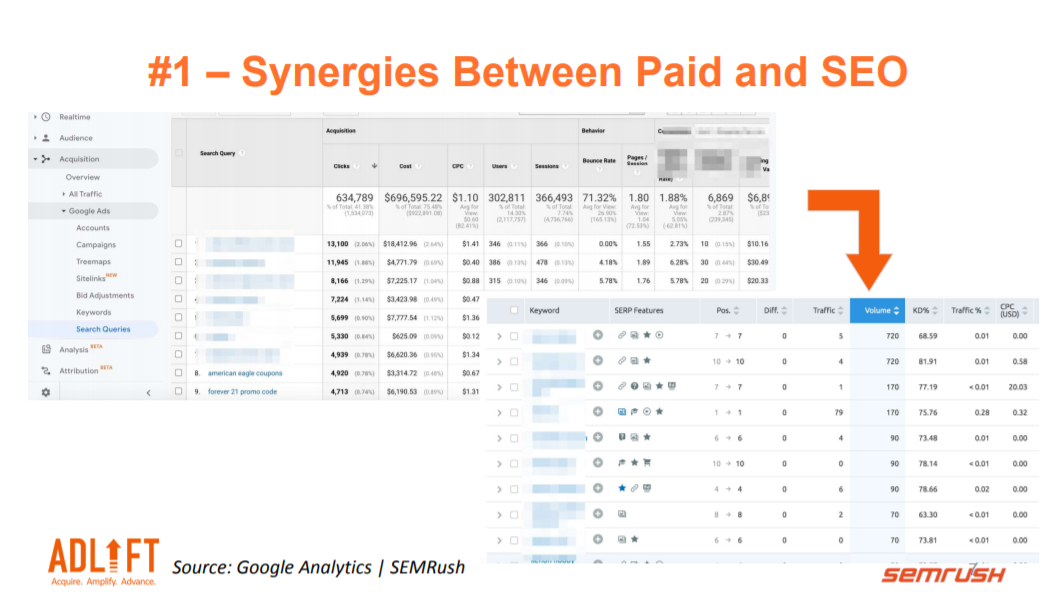
I’ve bubbled this up to number one because this is COVID times, right? This is where budgets are thin. We’re looking at every penny spent. If you’re part of the SEO team, it’s critical to talk to your paid media guys.
Figure out what keywords were working, what is currently now working, what’s the conversion rate, what’s the spend. Those should be your money keywords, your go-to keywords, part of your overall SEO strategy and vice versa, right?
If you’re into Google Search Console and you’re actually seeing a lot of traffic and stickiness with certain keywords, you want to shoot those over to your paid media team and make sure that they run their search query reports and it’s part of their mix. Synergies between paid and SEO teams is definitely number one.
Number two is scaling interlinking. This is AdLift’s internal data with Search Console for about 20, 25 of our clients, and what we did here was we graphed out non-brand impressions with interlinks. What you can see over here is there’s a strong correlation between the number of non-brand impressions that your website would get with how strong your interlinking is.
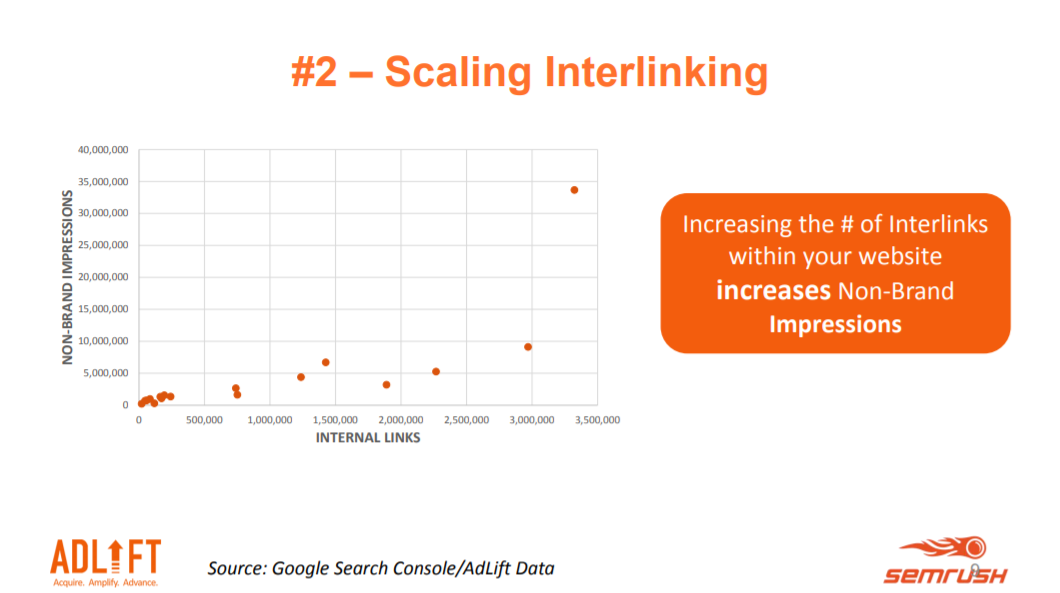
This one right here upfront, right on top, which has the most number of interlinks and also impressions is a new site, right? What that tells you is new sites typically do a really good job in interlinking. They’re working with different interlinking plugins across their platforms, and it’s automated.
If you’re not a new site, you’ve got to maybe work with different tools to get that in place, but it’s very important to scale interlinking as you grow your website because that’s one of the key ranking factors for Google.
Number three is one of my favorites, which is content marketing. It’s hacking backlinks; like it’s super important to understand what’s your current link profile and how do you actually grow that link profile with very quality links.
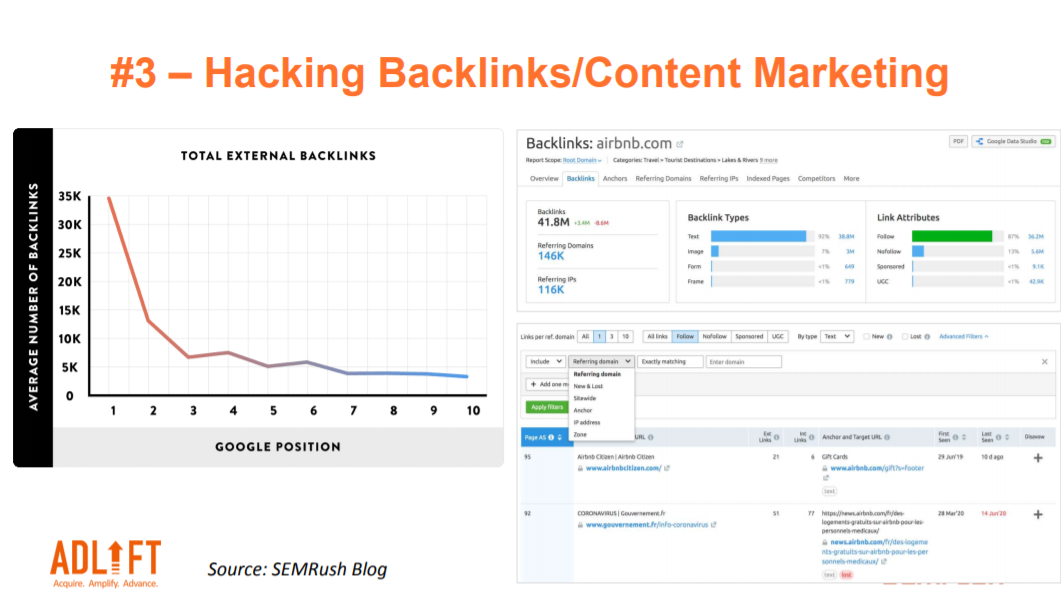
This is data from the SEMrush blog, which actually maps out Google’s keyword position along with a number of backlinks across a varied set of sites that were analyzed. What we’d recommend is using tools like SEMrush to actually understand what’s the quality of links that you’re currently getting, right?
What’s new? What’s lost? Going after the ones that are lost. Maybe this is because it’s a broken link. There’s some changes that happen with the dev team, a number of different reasons for that, but winning those back and growing those out.
Also, outreach, right? A lot of us are probably shy reaching out to high-authority sites When we do competitive research, we figure out certain competitors have links from really high domain authority sites. I would actually put that pretty high when I’m talking about hacking backlinks, right?
At AdLift, we use our own tool, which is Content Lift, which helps us do this at scale. If you like to talk more about how we do that, we’re happy to dive deeper, but we’ve got about 20,000 publishers working with us on driving global backlinks.
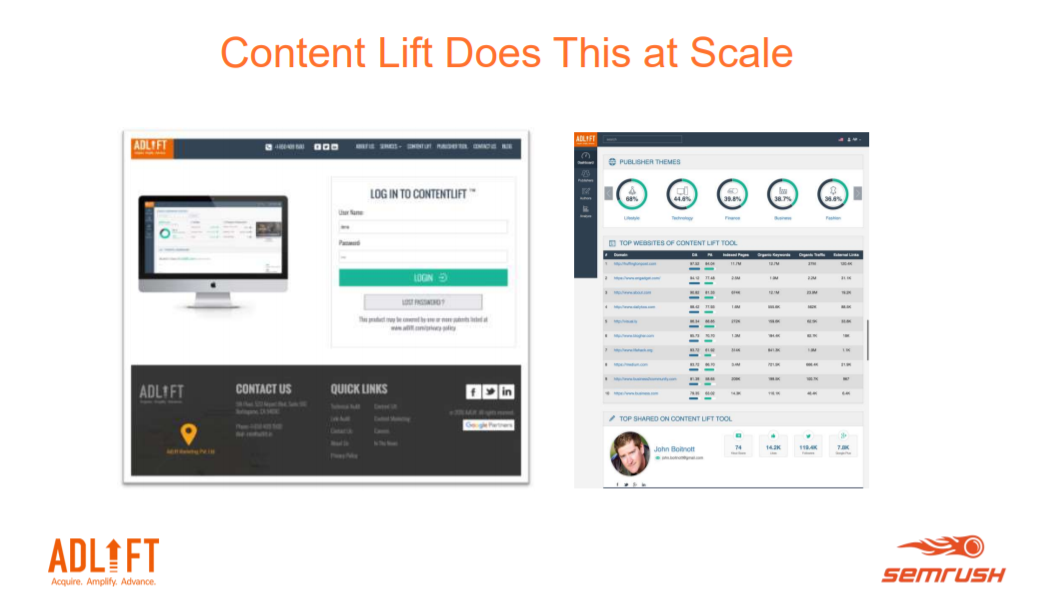
Number four is know your competitors. Comparative insight is key. Lots of times we’re pretty much rolled up our sleeves, and we’re getting into solving a lot of internal SEO issues without actually taking a breather and figuring out where am I currently, what’s my benchmark, and that’s something that at AdLift we swear by.
When we onboard a client, the first thing we do is create a benchmark report across the competitors. We ask for about four to five competitors, and then we use SEMrush, for example, here in creating where are you, what’s your percentage of SEO traffic currently, and the idea is to really grow that faster than the competitors to gain market share.
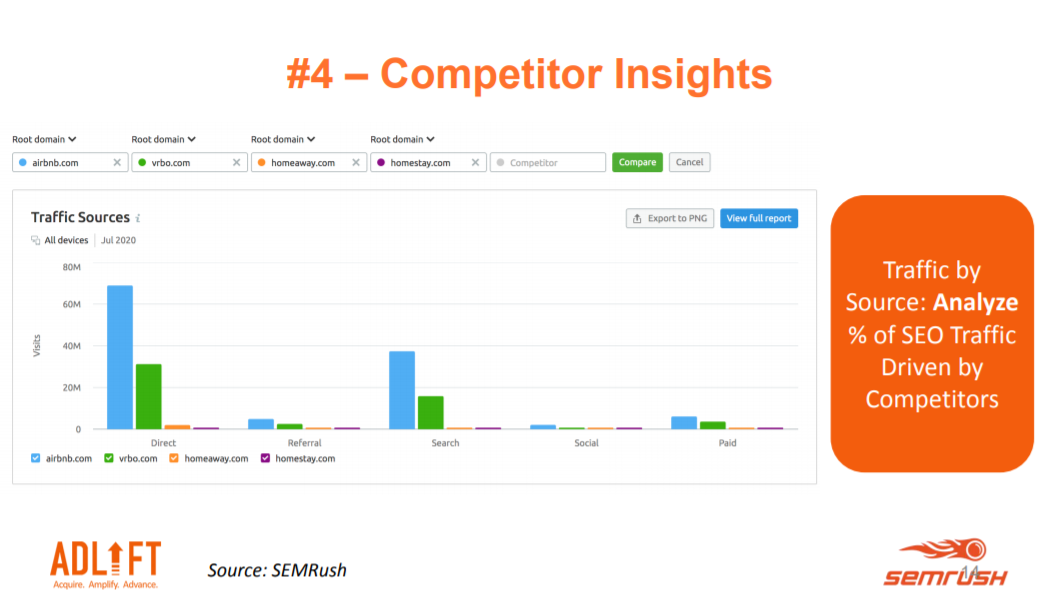
A keyword position spread is another key metric to map. How many keywords do I actually have in the top three? How many are in the top 10? And am I actually growing this out? When we look at SEO, you might be growing SEO traffic at 50% year over year or 110% year over year, but is that because the search volume has increased for those keyword sets or are you actually taking away from your competitor, right? Benchmarking those metrics becomes critical.
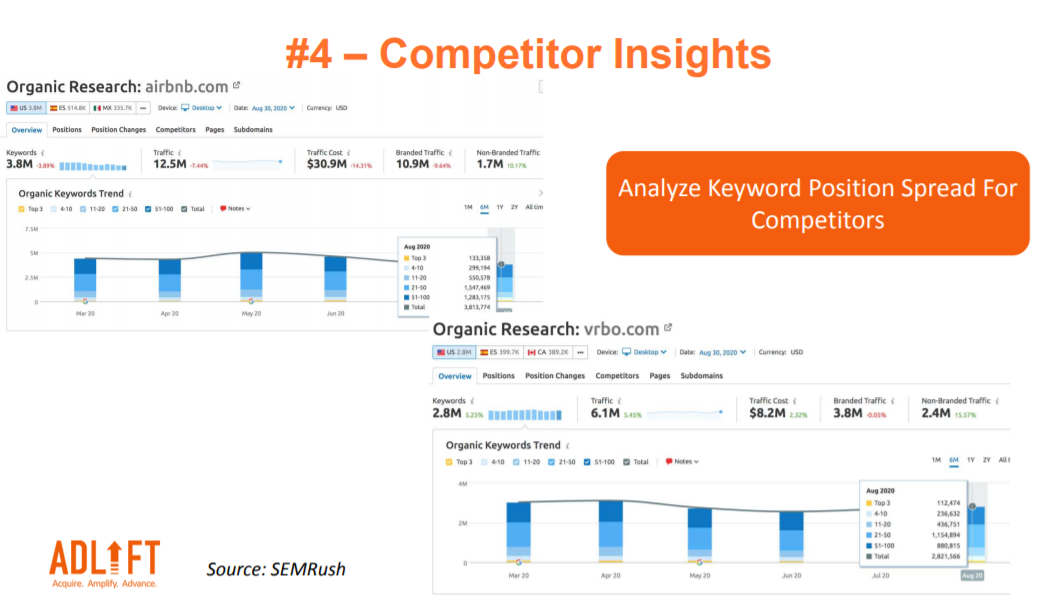
This segues really well into my earlier point, which was figuring out and hacking content marketing. One of the big things about content marketing is what kind of keyword should I go after? What kind of keyword should I actually create content from? Again, this is the keyword gap analysis that SEMrush provides you. Again, if you’ve not checked this out, I’d highly recommend it. Getting in, you can add your own website. You can add your competitor website, and what it spits out is very interesting data.
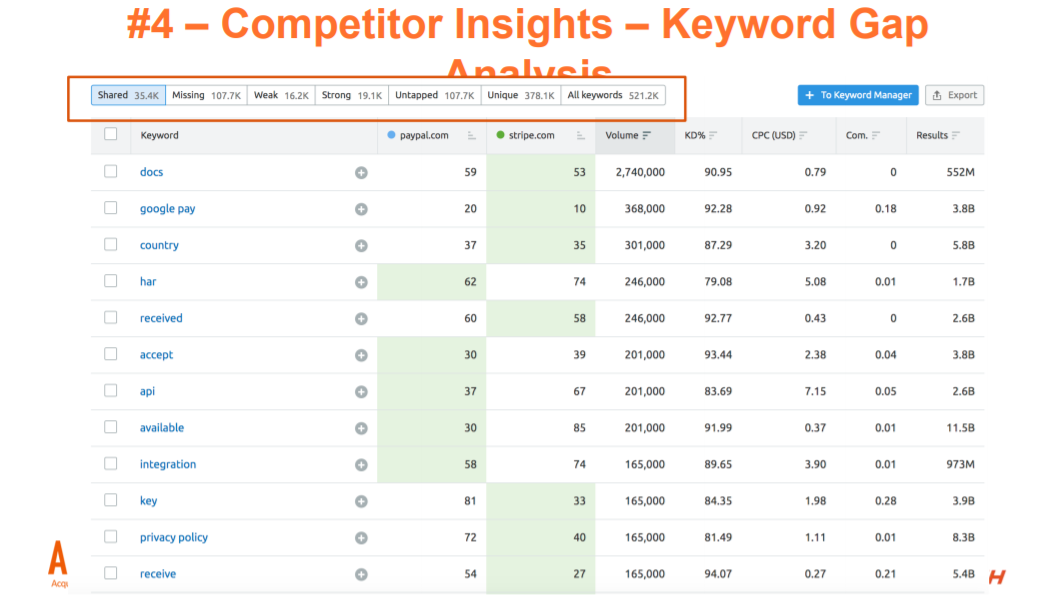
Lastly is page speed. I mean, this is super, super, super, critical, guys. We’re mobile-first. We cannot ignore this. It makes a significant difference when you increase your page speed from a 45, 50 to a 75, and this is not only for SEO. This is across the board, right?
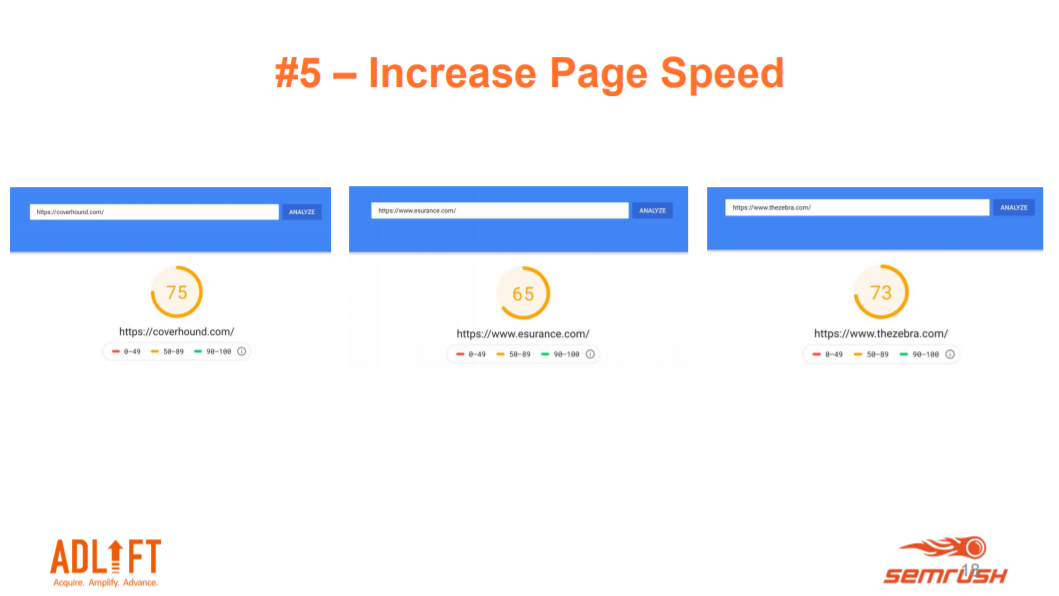
This would impact paid media conversions. This would impact direct, referral, all the different segments. Really working on page speed with your development team, getting this done, showing them these graphs.
There are other tools like Gtmetrix, Pingdom. Using the data points, really pushes forward the point that page speed is not only important for me, the SEO team, but across the board, it’s going to help everyone. Those are your five SEO growth hacks, guys.
Deepak Shukla:
Thank you for that, Prashant. That was really good. I think there was some fantastic insights in there. Interlinking to increase non-branded impressions makes a ton of sense. I think page speed is not talked about enough I think sometimes.
How Many Keywords Should You Target?
We’ve already had a question come in, which was of course about the number of keywords. It’s quite a good question actually. When you’re devising keyword strategy, what’s your answer to the question, “How many keywords are we targeting?” Prashant, is the question silly or how do you answer that question typically?
Prashant Puri:
I think this is a common question that we get, and the answer is you can’t go after keywords, right? That’s the short answer. Search queries on Google… 33% of search queries in a given quarter are new.
We don’t know what people are searching for. It’s always changing, right? I think the common pitfall is I’m a travel website, and I want to rank number one for hotels in Las Vegas. That’s not the way to go about it. What you need to do is your hotels for Las Vegas landing page needs to be so strong. Its authority needs to be so strong that variations of those keywords plus that keyword is something that you can rank for.
What our strategy would be is to build authority across landing pages. Of course, you need to track keywords and their tools to help you do that. SEMrush is there. It’ll give you longer-tail keywords, but don’t fixate on just a bunch of keywords. Obviously, you’ve got your money keywords, but it’s the landing page that you want to really focus on. Make that really strong, so that head, torso, and tail keywords rank for your landing page.
Deepak Shukla:
Makes a lot of sense. What would you say is the appropriate way to think about keywords? Because commercially, people are going to have targets. They’re going to think, “Well, my core keyword is still hotels in Las Vegas, Prashant. What do I do then given the fact that 43% of searches are new?” How would you go about that example?
Prashant Puri:
We definitely want to add that because that’s where you want to see. You were not ranking in the top 100. You’re a new player. You move to the top 50, top 20, so you need to see the transition happening, so you need to track that, right?
But what I’m trying to say is you don’t fixate on 10, 20, and 50 keywords for a landing page. Grow it out, and it obviously depends on the tool that you subscribe to. SEMrush gives you a plethora of data. So, track thousands of keywords, right?
Look at what’s working well for you. Once you then look at Google Search Console data, then you can map two and two together. I would say, and going back to my number one hack, which is marry it with paid media data, right? Speak to paid media folks. They’ve been doing it. They’re actually getting conversion data.
That’s something that us SEO folks struggle to get. We don’t have that. It’s all hidden behind and not provided. What I’m trying to call out here is don’t restrict yourself to a number of keywords. Track them all.
You can even segment them, right? Like there’s an enterprise client that we work with, and they’ve got this top 290 keywords, right?
Tips for Effective Internal Linking
Deepak Shukla:
Let’s go to Vaishak’s question. Could you make some comments on effective interlinking? Do you use a plugin or how do you think about your interlinking strategy to drive non-branded search?
Prashant Puri:
Yeah, so there’s a number of interlinking tools out there, like suppose you’re on WordPress, like Yoast, right? Interlink. You could use that if you’re a publisher, but it again depends. Are you in lead gen or are you in e-commerce? There are recommendation engines, product recommendation engines, plugins which do the job of interlinking.
I think where it gets a little tricky where you want to maybe look at Screaming Frog, for example, is if you’re an e-commerce website and you have a blog, right? The blog is your powerhouse to interlinking. Apart from all the different filters, interlinking that happens, recommendation engine, all of that, the blog is content, and within the content when you have links, it’s valued a lot more.
That’s where you can actually run the blog on Screaming Frog for custom filters. Let’s say I’m writing content on blue linen shirt or let’s say the top five summer wear, top five winter wear, and I want to start linking to my core product. That’s where you can use Screaming Frog to tell me, “Hey, I want to know for these custom keywords, show me where my content is that I’ve already written.”
Lots of times what we’ve seen is with clients is they’ve written a bunch of great content, but they don’t have any links in it, right? This is legacy content. It’s about three years old, four years old. It’s got some history in it.
Anchor text, link it to the product page, and we ship that out to the development team to go ahead and execute.
Deepak Shukla:
Fantastic. Fantastic. Guys, Screaming Frog, having a look at potentially if you’ve got legacy content or otherwise and just studying specific keywords and then looking at where there’s potential gaps in terms of your internal linking structure. Sounds like a fantastic way to ultimately improve the internal link.
How to Get into the Top 3 SERP Results
I think Abhinay Dasvasi asks, “What works when you are in the top five and are aiming for the top three spots?” It’s a variation of the same question. What’s your advice about people that want to break into the top three?
Prashant Puri:
To move from your top 10 or top five into the top three, you need to have content marketing in place. You need those inbound links. It’s going to be really tough to do that without it at least in my experience. If you want to get into the one or two, you need to do a competitive analysis for that specific landing page with your competitors, the ones that are the four, right?
Figure out how many links they are ranking for. How strong is their backlink profile and then try and beat that. If all things are the same and equal, that’s the way I would go about it. Now, if you’re up against a Walmart or an Amazon, I would say do that, but then don’t obsess on that head term.
You’ve moved it to four or five. Your landing page, your website’s stickiness, your page speed, all of that is going to help you move up with the content marketing. You’ve done a good job. Move over to other keyword sets. Start to get them up, right?
Because once you’re already in the five, yeah, start to do more content marketing aggressively, but there’s a lot more keywords that you can go after that you’re probably in the second page and moving them up to the top 10 or top eight would be money in the bank.
Combining Keyword Targeting and Content Marketing
Deepak Shukla:
You spoke a lot about content marketing and the importance of powerful content. Heranmita, straight after Ramesh, asked about when you think about developing a keyword or a content strategy with keywords, how do you correlate those two? How do you think about combining those two strategically?
Prashant Puri:
Yeah, again, so it dives into scale. Again, so that goes back to my reverse funnel approach, right?
Deepak Shukla:
Yeah.
Prashant Puri:
You want to go after money keywords. On day one, you can’t be writing 50 content pieces a day. You got to figure out what that threshold is. Then you got to map out that content strategy to the keywords that you want to move.
It has to be systematic in doing that, and obviously, create a content calendar. Figure out what’s the bandwidth, what’s the size of the team. Are you doing it yourself? You’ve got a team of 20 content writers. If you’ve got a team of 20 content writers, then you can write maybe 100 or 150 articles a month or a week, and that gives you a lot more breadth of keywords that you can go after.
If I was to draw out a framework, the first thing I would do is keyword research, obviously. Segment it based on primary, secondary, tertiary, or head, torso, tail: however you want to look at it. From that point on, your primary or your high search volume keywords would require more effort, more content.
Skew it that way, and this again fits into the fact of, “Is that what you want to move or do you want to move the lower search volume?” Answer that question. Start to generate content.
Deepak Shukla:
Guys, so slow and steady is really the way you need to think about the content game. Mapping out a content calendar is important in line with keywords and having a strategy behind it, and you combine this with the keywords you’re going after, and you put some of those other things in place.
What is a Good Keyword Density or Frequency?
I think it’s a really powerful way to ultimately move your actual SEO needle forward. Namrata Agrawal is asking like what’s… It’s a question that often comes up like, “How many times should you use a keyword in a piece of content? Is that the wrong way to think about a keyword? Does it become a point that it’s spamming?
My head keyword is hotels in Las Vegas. Do I keep using that keyword 57 times? How do you like to advise when you get asked this question?”
Prashant Puri:
Let’s say I want to buy insurance, and that could be like not the sexiest product out there. The content is something that I want to engage with. You can’t obviously plug in health insurance like 50 times because the entire purpose is to have a conversion and stickiness, right? S
You want to first create. You gotta ask yourself, “Would I read and consume the content?” It needs to be consumable. That’s what Google loves. That’s how the algorithm works, right? The days of keyword stuffing, unfortunately, are over. Freecreditcard.com, it doesn’t work. It used to work 15 years ago.
There’s got to be a balance. You got to figure out, “Yeah, I want to rank for car insurance.” You want to make sure you’ve got auto insurance in there. You’ve got car insurance. If you’re writing maybe a 15 to 1,500 to 2,000-word article, restrict that keyword to about three to five occurrences. That should be good enough.
Deepak Shukla:
Okay, so we’re looking at once to every three or 400 words. If you have to have a number, I know that there’s lots of SEOs who say, “You shouldn’t think in terms of numbers,” but there’ll be a lot of you mathematicians out there who’ll be getting out your rulers or using control find and trying to figure out, “Well, how many times have I mentioned it? What’s the keyword density?”
I think that’s a really safe way of thinking about it about three to five times in a 1,500 to 2,000-word piece of content.
How to Beat Established Competition at SEO
Dinpi Devan as well as I think Abhinay Dasvasi are asking quite a similar question. The question fundamentally is “I’m a new business. What hacks or what can I do when I’ve got really established competition?” If I’m trying to be my next local cab service and there’s already local established competitors, how do I make a dent when there’s already established competition?
Prashant Puri:
I think it goes back to a lot of the points that we’ve covered already, but I will focus on the technical stack. If you’re new, you got to sort that out first. One of the common pitfalls is,” you know what? I got to get the business up and running. I’m going to spend a bunch on paid media because that’s how I’m going to get quick traffic, and I’ll figure out SEO. It’s a headache. There’s too much to learn, do. I’ll figure that out some time else.”
What happens is over a period of time, you get addicted to paid media. Your margins, all of that get smaller and smaller, and then you wake up to the fact that, hey, I need to get SEO in place, but then you got to now change platform technology.
The first and foremost thing to do is make your platform SEO compliant. That’s super critical. Especially when you’re starting, that should be your goal one. Your technical SEO should be sound. You’ve got to get GSC, Google Search Console in place. Make sure it’s squeaky clean. There’s no duplicate content.
All of that needs to be in place, and then you start working across the five hacks that I talked about. If you’re already spending money on paid media, figure that out, figure out what keywords are working. Interlinking is used. Paid speed, which goes back to your SEO stack.
Deepak Shukla:
You’re talking about your technical stack. For someone who’s thinking, “What the hell is my technical stack?” What do you mean? Could you quickly run through, “These are the core things that you need to have in place when you get going”? What is the stack?
Prashant Puri:
The first thing I would do is get Google Search Console in place, and Google Search Console, you start learning it. Once you get that in place, you go down. You go down metrics or performance, so you see traffic, search queries.
Then you go into the errors. You start to see 404s, 301s, and if you don’t understand something, there’s the help section, right? There, you click through. They’ll explain it to you. Get Search Console in place. That’s your technical stack.
That should be zero errors. It gives you mobile responsive elements. Are you blocking certain pages? Robot.txt. Get Search Console in place and make sure once you have Search Console in place, you’re going through each of those checks and balances to make sure that your Search Console is giving you a grade A.
If I was to break this down, I would pretty much say, “Your mobile site has high page speed. Elements are properly defined. There’s no overlap.” Make sure that’s there. You don’t have duplicate content issues.
You don’t have URLs that you’re creating which Google doesn’t care about. I’ve seen this a number of times with e-commerce sites. When they use platforms, the filters start to create unique URLs. Google’s crawling it, and one thing to think about when I talk about technical SEO is every website is given a certain amount of time from Google.
Google can only crawl, can only give that amount of time to you because it needs to crawl Amazon and Walmart, and these guys have built that credibility that google’s going to spend servers and server time on them. I’m not saying it’s going to ignore you, but it’s going to give you very little time.
You’re going to make sure that the time Google gives you, it’s time well spent for Google, which means don’t make them crawl URLs that nobody’s searching for that nobody cares about. The way you do that is you can go into Google Search Console. You can do parameter handling, or you can add canonical tags. Again, fits into your technical SEO stack.
Is Voice Search Worth Considering for SEO?
Deepak Shukla:
I think that’s fantastic advice, and let’s keep going. Let’s have a look and see what else is being asked. This is an interesting one. What is your advice when you get clients who start asking what about voice SEO, what about Alexa SEO, what about Apple Search Engine SEO, what about platform-based SEO whether it’s Amazon or eBay? How do you like to think about SEO that’s particular to specific platforms?
Prashant Puri:
I think I read a data point that voice is going to be or it’s close to 22% of searches today on Google. Could be higher, but that’s the range. Voice is definitely important. There’s Alexa optimization that’s happening too. If you’ve got your SEO already in place, and you’ve got bandwidth now to start working on voice and Alexa and all the different gadgets, I mean, I would totally go for it but first, get the house. I would say get the house in order.
Before you even go to voice, especially for all the folks in India where the land of multiple languages, vernacular is huge. Vernacular SEO is massive, and that’s something that we’ve seen with clients in India where we spent a bunch of time on optimizing for English, but when we created landing pages in Hindi, there was no competition, and we’re talking about roughly 500 million internet users…and upwards of about 200, 250 are non-English.
That’s untapped, right? This could be true in other parts of the world also, right? Whether it’s Canada, you’ve got two languages there. I would say you should go vernacular first before obviously going to voice, but absolutely. I mean, if you’ve covered the bases, go for it. That’s the home run.
Can Ad Spending Help Organic Traffic?
Deepak Shukla:
Abhinay is asking a good question. This is in relation to paid and organic, and it relates to your point number one, I think, that was on your actual slides. The question is like, “Can spending on ads and AdWords help organic traffic and then how?”
Prashant Puri:
The question that I saw come up on the screen was does paid help SEO? It doesn’t. It’s church and state, okay? Completely different. What has happened or what you’d probably see is we’ve had startups saying, “You know what? We had zero SEO, but then we started spending money, and boom, our SEO traffic started to go up.”
Now, in those instances, typically what happens is you’ve got Googlebot bot and you’ve got adbot, right? Now because your SEO is weak, Googlebot doesn’t spend too much time. There’s no interlinking, none of that, so it gets out all the errors, all of that stuff, but because you’re spending money, Google gives you adbot, and adbot spends a lot more time and speaks to Googlebot.
That correlation would get you higher traffic, but if you’re a startup, if you just started out, it has no correlation if you’re a Walmart or an Airbnb. You can’t buy your way through. If you’re really new, you’ve just started spending. Adbot would send signals to Googlebot and say, “Okay. Crawl this website. See if it can rank.” It’s not going to do a whole lot, but it’ll be better than 10 visits a day, probably, right?
That’s the only correlation there. It’s a misnomer to think if I spend more, I’m going to get more SEO traffic. That’s not true. That’s incorrect. Paid and SEO have to talk to each other because paid media has your conversion data. I know how much I’ve spent on white linen shirt. I know what the conversion rate is. I know what the time spent on the site was.
I’ve got all of that data, and I can compare that with yellow linen shirt and blue and red and a skirt or whatever, like other products that I have. I know which keywords I do really well in thanks to paid media.
That’s the correlation I would actually concentrate on working is if you’ve got budgets, and you can’t wait for SEO. Take the help of PPC. Take the help of paid media of AdWords to talk to your SEO team or talk to your SEO structure and optimize for that.
Deepak Shukla:
I think that that’s excellent advice. Let’s not make the assumption that paid is going to boost organic, or if it looks like it does, it’s not the data that actually reveals what’s actually happening.
There’s a distinction between the bots, and really the way to think about it is understanding what’s the conversion data that we can feed back into our SEO strategy to help support that content calendar, the outreach that we do, and the keywords we identify as being meaningful from a conversion standpoint.
Outreach Strategy: Getting Backlinks
Let’s talk a little bit about the outreach process now in the world of building links. I think Shavan Kumar says that he guesses that outreach for backlinks is the key, and what’s your broad approach with how you would think then about backlinks and link building? Is there any kind of specific insights that you’ve got on that?
Prashant Puri:
I think backlinks is in my experience maybe 40, 45% of Google’s algorithm, right? You need to have a structure in place. Now, there are a number of different ways you can do that. One is the webinar that we’re doing, right? Deepak? That’s helping with the backlink right there, right?
Deepak Shukla:
Yeah.
Prashant Puri:
That’s thought leadership, right?
Deepak Shukla:
Yeah.
Prashant Puri:
Creating really good content. If you’re selling a certain product, be good at that product. On digital magazines, talk about that product. Become a thought leader. Thought leadership is one.
Competitive analysis, figuring out where competitors are getting links from, and then reaching out to folks and saying, “Hey, you know what? You guys cover this space really well, which is in the lighting space, and I do bathroom lights really well, and this is my product set. I would love to contribute.”
I mean, I think you got to get innovative. Everyone wants content, but they don’t want content that’s already… It’s been there, done that. They want something fresh.
Deepak Shukla:
Absolutely, guys. I think that’s fantastic advice, and the only one thing I’d add to that is if you’re thinking about, well, how can I demonstrate thought leadership? It can begin on your own platforms before you migrate to others, okay?
Thank you for all of your advice. I think it was fantastic. As we can see from everyone’s comments, we really appreciate your time, really appreciate you staying to the end. Prashant has given so much amazing information. Message him, hire him, all of that good stuff, and meanwhile, keep coming back of course to SEMrush. I’ll catch you on the next webinar. Prashant, thank you so much.
Prashant Puri:
Thanks so much, Deepak. This was fantastic. Thanks for having me.
Recent Posts
- Google Search Revolutionized for Educational Videos November 16, 2023
- Bidding Adieu to Google’s Page Experience Report November 9, 2023
- Google November 2023 Core Update November 3, 2023
- Unmasking Google’s October 2023 Spam Update October 5, 2023
- Unleash SEO Power: Must-Have Chrome Extensions for Website Success September 20, 2023
- SEO-Friendly URL Optimization: Mastering Structure for Better Ranking September 20, 2023
- Real Estate Marketing Ideas: Crafting a Results-Driven Marketing Strategy September 20, 2023
- The Anatomy of a Broken Link: Causes, Effects, and Solutions September 15, 2023
- Crafting an Informative FAQ Section: A Step-by-Step Guide September 14, 2023
- Local Business Schema Markup: Elevate Your Brand With The Magic September 14, 2023
Get
in Touch
Contact AdLift for a 360-degree marketing plan
